|
|
|||
|
(Back to Preceding Week; on to Next Week) |
|
HUMMINGBIRD MIGRATION, In late winter and early spring, the most common question we get via phone or e-mail at Hilton Pond Center is when to put out hummingbird feeders. All across the eastern U.S., hummer enthusiasts eagerly await arrival of their first Ruby-throated Hummingbirds (RTHU)--tiny Neotropical migrants that spent the preceding six months in Mexico or one of the seven countries of Central America. Ruby-throats as a species take their time moving northward, arriving in the Gulf Coast states as early as the last part of February but not getting to southern Canada until mid-May. (One researcher found RTHU migrate north at the same rate as the 35-degree F isocline, meaning they get to a given locale about when the average overnight temperature is barely above freezing.) All text, maps & photos © Hilton Pond Center Info about isoclines isn't instantly available to most hummingbird enthusiasts, so to help folks know when to expect the first ruby-throats we've consulted several sources and our own records to develop the map above. Blue lines indicate average early RTHU arrival dates; however, individual birds may show up a week or more ahead of average, so to be safe a feeder should be up slightly BEFORE expected first showings. For example, at Hilton Pond Center--which lies barely south of the 1 April line--we always have our feeders hung by the end of the third week in March. Sure enough, our earliest-ever Ruby-throated Hummingbird arrived 27 March 1991, while this year we had a pristine plumaged adult male on 31 March. (During our 29 years of record-keeping at the Center, the first male RTHU typically has appeared on or about4-5 April.) Some folks put up their feeders AFTER spotting their first spring hummers, but people who say they never see hummingbirds before June or July probably haven't been looking closely enough. Thus, we highly recommend following the time line on the map above and having at least one freshly filled feeder hanging BEFORE hummingbirds get back from the Neotropics.
Adult male Ruby-throated Hummingbird (above), 22 March 2010 All text, maps & photos © Hilton Pond Center At Hilton Pond Center we've been banding and closely monitoring Ruby-throated Hummingbirds since 1984. (The Center's general banding program actually started when we moved to the property in 1982.) Originally we simply wondered how many ruby-throats we had at numerous feeders around Hilton Pond and figured the only way to get a better fix on local population sizes was through banding and recapture, In nearly three decades since, our interest in hummingbirds has broadened and deepened far beyond just wondering how many ruby-throats we host each year. Since that fateful day in July 1984 we've captured and banded more than 4,000 individual RTHU at Hilton Pond Center, most of which we never saw again after release. Nonetheless, about 12% of our banded hummers return in at least one later year, indicating significant site fidelity. Some have returned and been recaptured for five years following banding, demonstrating RTHU longevity of at least six years. We've also learned that around Hilton Pond in any given year young males outnumber young females by a 3:2 margin, but the ratio is reversed among adults--leading us to conclude an "overabundance" of young males eventually dies at a higher rate than young females. This seems morbid but works for Ruby-throated Hummingbirds that reportedly follow a "harem" system--i.e., a breeding male mates with more than one female. Among many other aspects of Ruby-throated Hummingbird behavior, we've had long-term interest is arrival and departure dates for the species. One big problem with school-based data collection is that Ruby-throated Hummingbird phenology conflicts with school calendars; the "best" hummer activity on North American breeding grounds occurs June through August when U.S. and Canadian schools are on summer break. (And, conversely, optimal months to observe ruby-throats within their non-breeding range in Central America are December through February--just when kids down there are on their long mid-winter break.) We doubt school boards or hummingbirds are going to switch their calendars for the sake of Operation RubyThroat, so we've been looking for a way to expand year-round hummer data collection to citizen scientists--especially adults whose lives don't necessarily revolve around an academic calendar.
Although we also trained 150 or so non-teachers in the Operation RubyThroat/GLOBE hummingbird protocols, we still wanted a more user-friendly adult-oriented venue through which the general public could report hummer observations. That came last fall via EarthTrek, a new citizen science collaborative started by the Geological Society of America. EarthTrek selected Operation RubyThroat as one of its three pilot "citizen science" programs. The other two are: The Gravestone Project (which uses tombstones in graveyards around the world to measure weathering rate of marble and, indirectly, acidity of local rainfall); and the Garlic Mustard Field Survey (which looks at growth rates and densities of invasive populations of Garlic Mustard from Europe). All three projects are open to citizen scientists of any age. To participate, one need only register with EarthTrek, begin making observations, To participate in any of the EarthTrek programs, The Operation RubyThroat EarthTrek protocols look at three aspects of RTHU behavior: 1) Early Arrival Dates--during spring in U.S. & Canada, and during autumn in Mexico & Central America; 2) Late Departure Dates--during autumn in U.S. & Canada, and during spring in the tropics; and, 3) Nesting Behavior--including dates for nest-building, egg-laying, incubation (above right), hatching, and fledging, as well as info about failed nests and double- or triple-brooding. One would think all this information is already well-known about the most widely distributed hummingbird in the world but, quite frankly, it isn't--and that's where YOU can help as a citizen scientist.
Adult female Ruby-throated Hummingbird (above), 2 March 2010 All text, maps & photos © Hilton Pond Center A few other sources have collected data about migration in Ruby-throated Hummingbirds. Since 1997, for example, Lanny Chambers (hummingbirds.net) has done a terrific job creating maps of spring arrival dates of RTHU for the U.S. and Canada. Operation RubyThroat through EarthTrek goes a step further in asking you to report arrival dates of RTHU by sex. In spring it's easy to differentiate male ruby-throats (with their metallic red gorgets; see top photo) from females (whose throats lack red and are white or sometimes faintly streaked in buff; photo just above). Conventional wisdom is that the male RTHU returns first to a given breeding locale and establishes a territory, with females arriving a week or ten days later--but no one knows if this is true for all North American sites and/or if arrival dates vary by altitude or some other environmental factor. And if you live in Mexico or one of the seven countries of Central America--Operation RubyThroat/EarthTrek offers a chance for you to submit much-needed data on when RTHU arrive at their wintering grounds. There are plenty of U.S. expatriates living in the tropics who are familiar with ruby-throats and can contribute info about AUTUMN arrival dates, and sometime soon we hope to have Spanish-language versions of the EarthTrek forms so ticos from Costa Rica and nicas in Nicaragua can also log observations in their native tongue. What ruby-throats do in the Neotropics is pretty important; after all, they're down there for half the year!
Second-year male (immature) Ruby-throated Hummingbird (above), All text, maps & photos © Hilton Pond Center We're also interested in when you see your last Ruby-throated hummingbird in fall in the U.S. and Canada, and--again--information about the apparent age and sex of the bird is of value. Adult male RTHU with full red gorgets probably start heading south as early as the end of July and are thought to be followed not long afterwards by adult females. White-throated birds in fall might be either young males or females of any age, but a bird with heavy throat streaking or red speckles on its throat (above) undoubtedly is an immature male. To our knowledge, no one else is systematically compiling info about when the last RTHU depart the U.S. and Canada in autumn, nor is anyone looking at SPRING departure dates from the species' non-breeding grounds in Mexico and Central America. Our banding work in Costa Rica suggests adult male ruby-throats are already moving north from that country by mid-February; this year in Belize we observed an apparent northbound wave of adult males in mid-March--at which time we were still capturing immature males with incomplete red gorgets. Observations of late dates for migrant hummers in various parts of Central America could lead to better understanding of the role Ruby-throated Hummingbirds play in Neotropical ecology--e.g., as pollinators of spring-flowering plants. All text, maps & photos © Hilton Pond Center Our collaboration with EarthTrek brings Operation RubyThroat to a new level at which many more participants--backyard birders, teachers, students, and hummingbird enthusiasts--can act as "citizen scientists" and contribute observations about Ruby-throated Hummingbirds from all ten countries in which the species occurs. We've already led more than 125 people on ten successful RTHU banding expeditions (see map above) to Costa Rica (Liberia/Cañas Dulces) and one to Belize (Crooked Tree), and we've banded independently at Lake Atitlán in Guatemala and at El Salvador's Cerro Verde National Park. In 2011 we'll return with new 12-person groups to Belize and Costa Rica and, for the first time, to Mombacho/El Jaguar in Nicaragua and Guastatoya in Guatemala. (More about those trips in next week's installment of "This Week at Hilton Pond.") And, just as exciting, we're now starting to get Operation RubyThroat/EarthTrek reports from Central America:
You may not live someplace exotic like Panama or Costa Rica and you may not be able to travel with us on a banding expedition to Nicaragua or Belize. One never knows whether data YOU submit will be a critical piece of Ruby-throated Hummingbird information that, in turn, helps us understand better how to protect these long-distance migrants that return to North American feeders each spring. Your hummingbird sightings ARE important, so please take time today to share your data with Operation RubyThroat/EarthTrek. If you enjoy hummers and report your observations, you truly ARE a "citizen scientist." Happy Hummingbird Watching! All text, maps & photos © Hilton Pond Center
|


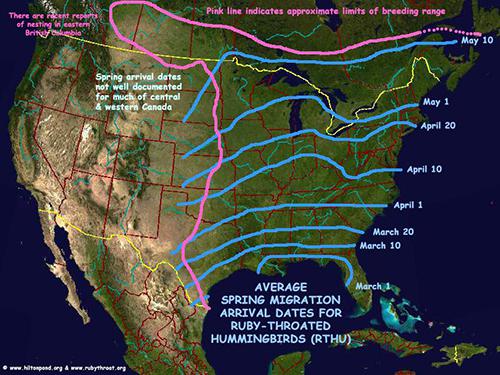
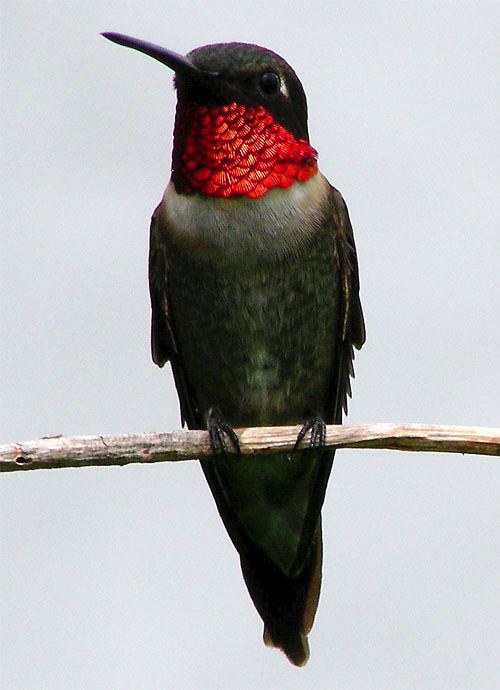
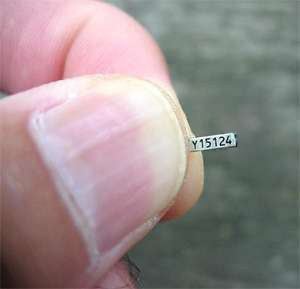 so we applied for a hummingbird permit because the federal Bird Banding Laboratory (BBL) requires a special permit to work with hummers--in part because bands (left) have to be formed individually. We suspected we had about two dozen RTHU partaking of sugar water outside our old farmhouse; we received our hummingbird authorization on 25 July 1984 and, surprisingly, within just one week banded 75 ruby-throats--three times what we had predicted.
so we applied for a hummingbird permit because the federal Bird Banding Laboratory (BBL) requires a special permit to work with hummers--in part because bands (left) have to be formed individually. We suspected we had about two dozen RTHU partaking of sugar water outside our old farmhouse; we received our hummingbird authorization on 25 July 1984 and, surprisingly, within just one week banded 75 ruby-throats--three times what we had predicted. To this end, back in 2003 we applied for and received a 42-month grant from the National Science Foundation to design and teach methods by which educators (and, indirectly, their students) could report data about RTHU behavior. In conjunction with The GLOBE Program--an international science ed initiative that involves K-12 students around the world--we created protocols for observing ruby-throat migration, feeding, and nesting activity. During the past eight years we've trained more than 600 classroom and informal educators, some of whom have involved their students in Operation RubyThroat and GLOBE.
To this end, back in 2003 we applied for and received a 42-month grant from the National Science Foundation to design and teach methods by which educators (and, indirectly, their students) could report data about RTHU behavior. In conjunction with The GLOBE Program--an international science ed initiative that involves K-12 students around the world--we created protocols for observing ruby-throat migration, feeding, and nesting activity. During the past eight years we've trained more than 600 classroom and informal educators, some of whom have involved their students in Operation RubyThroat and GLOBE.
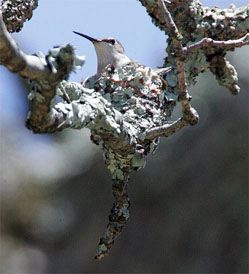 and submit data via EarthTrek's user-friendly on-line forms. It's all FREE--there's no charge to sign up--and anyone can contribute data.
and submit data via EarthTrek's user-friendly on-line forms. It's all FREE--there's no charge to sign up--and anyone can contribute data.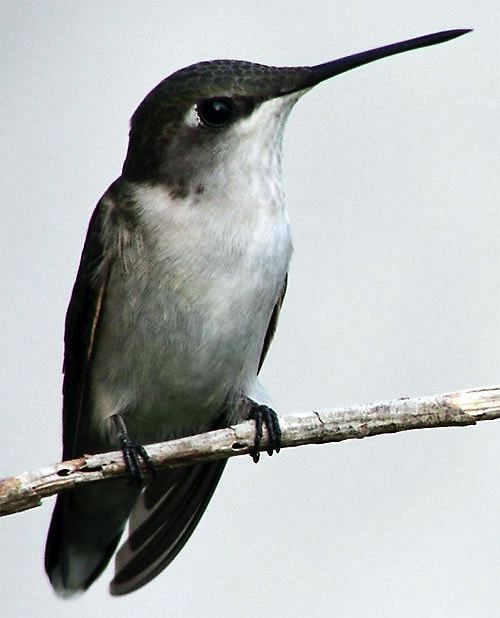
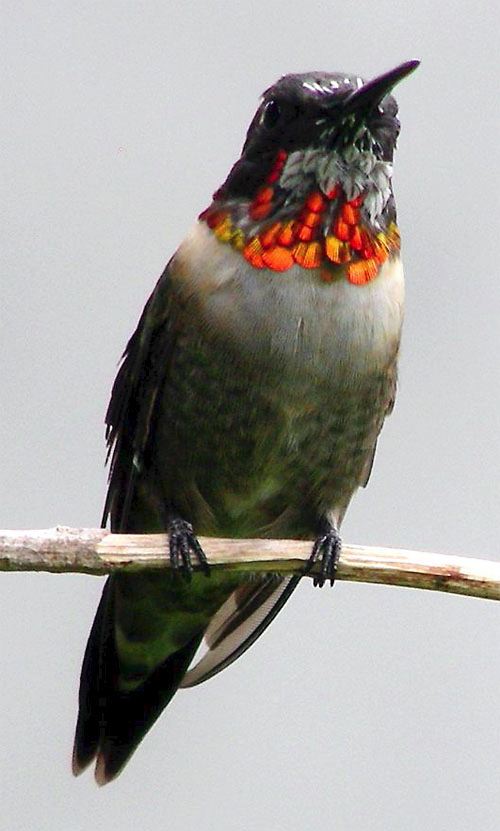
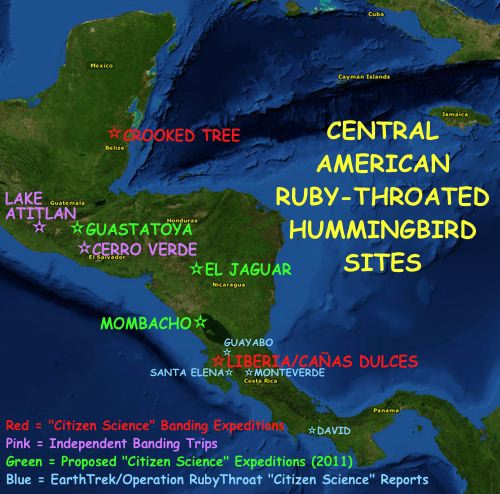
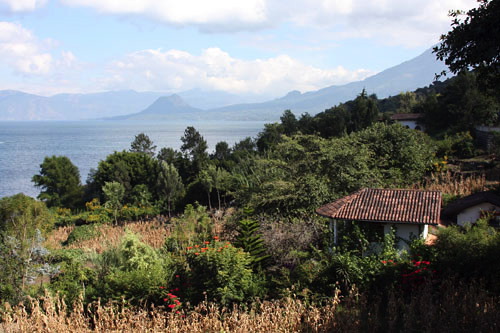 Carol Anderson, who lives on the shores of Lake Atitlán at San Pedro (right) provided valuable information about wintering Ruby-throated Hummingbirds in Guatemala and hosted us when we banded 57 hummers there in 2008.
Carol Anderson, who lives on the shores of Lake Atitlán at San Pedro (right) provided valuable information about wintering Ruby-throated Hummingbirds in Guatemala and hosted us when we banded 57 hummers there in 2008.
